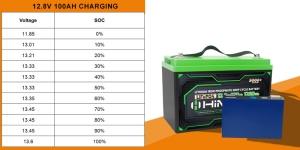12.8V 100Ah LiFePO4 battery SOC correspondence
Introduction
Lithium Iron Phosphate (LiFePO4) batteries are not just another battery type; they represent a significant leap in technology, offering advantages that make them particularly suitable for energy-intensive and safety-critical applications. Their widespread use in sectors such as renewable energy, automotive, and consumer electronics underscores their importance. The ability to accurately measure and understand the State of Charge (SOC) of these batteries is crucial because it directly affects their efficiency and longevity. A well-managed SOC ensures optimal performance and can significantly extend the life of the battery by preventing overcharging or excessive discharge, which are primary causes of battery degradation.

Part 1: Fundamentals of LiFePO4 Batteries
- Overview of Battery Technology:LiFePO4 batteries are renowned for their stability and safety due to their chemistry. Lithium iron phosphate as a cathode material provides a stable structure which does not undergo significant volume changes during electron discharge and charge, thus preventing structural degradation and extending battery life. This stability also minimizes risks such as thermal runaway, which is a common concern with other lithium-based batteries.
- Specifications and Applications of 12.8V 100Ah Batteries:This specific battery configuration offers a balance of voltage and capacity that is ideal for applications requiring long-term, reliable power without frequent recharging. In recreational vehicles (RVs), these batteries can power lighting, HVAC systems, and small appliances, often for several days without recharging. For solar power systems, the 12.8V 100Ah battery serves as a backbone for storing solar energy harvested during the day to be used at night or during low sunlight periods, ensuring a consistent power supply.
Part 2: What is SOC and Its Importance
- Definition of SOC:The State of Charge is a critical parameter in battery management, reflecting the current state of energy available compared to the battery’s maximum capacity. It is crucial for operational management, especially in scenarios where energy efficiency and battery health are paramount. It allows users to make informed decisions about energy use, which is particularly important in off-grid solar systems or during long trips in an RV.
- Methods for Measuring SOC:Accurate SOC measurement can be challenging but essential for proper battery management. Voltage measurement, though common, can be misleading if the battery is under load or has just been charged. Coulomb counting integrates current flow over time to provide a more accurate depiction of charge in and out, but requires sophisticated circuitry and calibration. Impedance spectroscopy, which measures the internal resistance of the battery, can provide insights into battery health that correlate with SOC but typically requires specific equipment and can be more complex to interpret.
Part 3: SOC Correspondence for 12.8V 100Ah LiFePO4 Batteries
- SOC Changes During Charging:As the battery charges, its voltage and SOC increase according to a characteristic curve that depends significantly on the charging rate and temperature. Understanding these relationships is crucial for setting up charging systems, especially in solar applications where charging conditions can vary widely with weather conditions and seasonality.
- Discharge Process and SOC Chart:Providing a detailed SOC chart allows users to plan energy use more effectively. For instance, knowing that a battery at 50% SOC in an RV might last through the night without additional charging can help in planning energy usage around available capacity. Such charts also help in assessing when a battery needs recharging to maintain health and efficiency.
Part 4: Optimizing Your Battery’s SOC Usage
- Strategies for Enhanced Battery Efficiency:Effective strategies for SOC management include setting limits on maximum and minimum SOC to avoid stressing the battery. For example, not allowing the battery to fall below 20% SOC can help prevent deep discharges that are harmful to LiFePO4 batteries.
- Avoiding Common SOC Management Mistakes:A common mistake in SOC management is neglecting temperature effects. Battery chemistry is temperature-dependent, and both charging and discharging at temperatures that are too high or too low can reduce efficiency and lifespan. Proper insulation and temperature management can mitigate these effects.

Conclusion
Effective management of the State of Charge in your 12.8V 100Ah LiFePO4 battery is not merely about prolonging its life but also about harnessing its full potential in terms of performance. Proper SOC management, through accurate measurement and mindful usage, ensures that the battery delivers its best performance throughout its lifespan.
About Himax Electronics
Himax Electronics stands at the forefront of LiFePO4 technology, providing innovative solutions tailored to meet the rigorous demands of various industries. Our commitment to quality and sustainability makes us a preferred partner in the energy sector. By choosing Himax, you are not only opting for top-tier battery technology but also supporting a vision of sustainable, reliable energy solutions for a greener planet.



